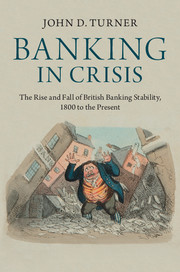Book contents
- Frontmatter
- Contents
- List of figures
- List of tables
- Acknowledgements
- 1 Introduction: Holding shareholders to account
- 2 Banking instability and risk shifting
- 3 The evolution of British banking structure and stability since 1800
- 4 Major and minor British banking crises since 1800
- 5 Banking stability, shareholder liability and bank capital
- 6 Averting or creating banking crises? The lender of last resort and bank rescues
- 7 Banking stability and bank regulation
- 8 Restoring banking stability: Policy and political economy
- Bibliography
- Index
- References
7 - Banking stability and bank regulation
Published online by Cambridge University Press: 05 July 2014
- Frontmatter
- Contents
- List of figures
- List of tables
- Acknowledgements
- 1 Introduction: Holding shareholders to account
- 2 Banking instability and risk shifting
- 3 The evolution of British banking structure and stability since 1800
- 4 Major and minor British banking crises since 1800
- 5 Banking stability, shareholder liability and bank capital
- 6 Averting or creating banking crises? The lender of last resort and bank rescues
- 7 Banking stability and bank regulation
- 8 Restoring banking stability: Policy and political economy
- Bibliography
- Index
- References
Summary
Our tradition in Britain is of a less formal system of supervision than is customary in some other developed countries; and my long experience has not weakened my faith in this tradition.
Lord O’Brien of LothburyHBOS has prudent corporate credit provisions in place. Issue closed.
Financial Services Authority evaluation, October 2007Introduction
In Chapters 5 and 6, we discovered the following: (1) shareholder capital started declining during World War I and by the 1950s, it had reached exceptionally low levels; and (2) by the early twentieth century, the Bank of England and the Treasury were reluctant to see banks collapse; as a result, a policy emerged that meant that the banking system (and the major clearing banks in particular) were essentially insured by the Bank and taxpayers. As a consequence of these two developments, the potential for risk shifting was accentuated because shareholders (and depositors) stood to lose relatively little if their bank collapsed, with taxpayers ultimately bearing a substantial proportion of the downside risk. However, this chapter describes how bank regulation acted as a check on risk shifting by banks for four decades or more after 1939.
In this chapter, we perceive bank regulation as rules that constrain banks from risk shifting even if the stated or actual rationale for the rules is unrelated to constraining bank risk taking. Bank regulation takes three forms in this chapter. First, there is the informal and nonstatutory regulation of banks by the Bank of England, with the Bank making its wishes known through ‘nods, winks and raised eyebrows’ rather than regulatory edicts. Second, there is economic regulation, whereby banks are subject to nonstatutory controls as an integral part of the government’s monetary, credit and fiscal policies. Third, there is statutory regulation that is prudential in nature; that is, its rationale is to prevent banks from taking excessive risks.
- Type
- Chapter
- Information
- Banking in CrisisThe Rise and Fall of British Banking Stability, 1800 to the Present, pp. 173 - 203Publisher: Cambridge University PressPrint publication year: 2014



